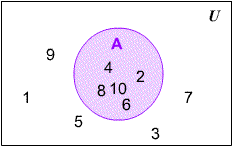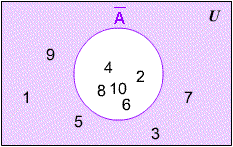Q. Explain Venn diagrams?
Ans.
Venn diagrams, named after the Englishman John Venn, are "area" or "region" diagrams that can be used to help visualize and organize different sets.
Here is an example: Let U, the universe, be the set {1, 2, 3, 4, 5, 6, 7, 8, 9, 10}. Suppose A is the subset of all even numbers contained in U. A Venn diagram can be used to visualize this:

The shaded region shows the subset A. Notice that all of the even numbers between 1 and 10 are located inside the circle labeled A. The rectangle, labeled U, is called the universe, and you can see that all of the numbers 1, 2, 3...9, 10 are listing inside the rectangle.
The next Venn diagram shows that the complement of A, denoted  , is the set of all elements ofU, which are not in A. In set notation, we write:
, is the set of all elements ofU, which are not in A. In set notation, we write: 
This is read "The complement of A is all x such that x is an element of U and x is not an element of A."

A quick note about spelling: Be careful about the way you spell the word "complement". The math term is spelled with an "e". We are not talking about compliments, which are nice things people say to each other.